



This study analyzed the factors that influence the research productivity of 236 graduate students who are funded by the Global Ph.D. Fellowship Program of the National Research Foundation of Korea. Research productivity was measured by the number of SCI publications, and the explanatory factors are the demographic factor, the financial factor, the reputation of institutions and the supervisor factor. This study included 2 indices such as the reputation of institutions and the research productivity of supervisors to check the halo effect unlike other studies. Results are as follows: 1) no gender difference, 2) better performance by younger age group, 3) no difference even if the students are additionally funded by other research support programs, 4) no halo effect by the reputation of institution but rather better performance from low ranked universities, 5) and a positive halo effect by supervisors.
All nations support graduate students to foster future researchers. Well-known programs are the Graduate Research Fellowship provided by the National Science Foundation (NSF) in the U.S., the funding programs for world-leading researchers supported by the Japan Society for the Promotion of Science (JSPS) and the Global Ph.D. Fellowship Program (GPF) provided by the National Research Foundation of Korea (NRF). However, research productivity of those backed up by government programs has yet to be fully investigated.
Many studies on research productivity have focused on evaluation criteria and explanatory variables (Avital and Collopy, 2001), and the number of suggested explanatory variables mounts up to approximately 200 (Babu and Singh, 1998). Nonetheless, many of these studies examined the factors for successful degree achievement (Rudd 1985; Becher et al. 1994; Wright and Cochrane, 2000; Ours and Ridder, 2003); thus, there is still a lot to investigate regarding the factors that affect the graduate students’ research productivity during their academic term. These factors have not been well explored mainly because it is difficult to obtain the data that indicates the research productivity of graduate students.
This study obtained data from the GPF program by NRF of Korea. The GPF program requires students to report their research activities annually. Therefore, this study aims to investigate the factors that affect the research productivity of graduate students supported by the GPF program.
To achieve this goal, this study overviews the research grant programs of the National Research Foundation of Korea and the previous studies on the factors that affect research productivity of graduate students in Chapter 2. In Chapter 3, this study proposes a research model based on the influencing factors investigated in the previous studies, and establishes hypotheses. Chapter 4 presents the statistical result of the analysis and Chapter 5 summarizes the results and suggests the theoretical and practical significance and limitations of this study.
NRF is a government agency established to contribute to academic enhancement, and science and technology promotion, as well as competent enhancement of research, similar to the National Science Foundation in the U.S. The programs provided by NRF are classified into two: support for individuals and for groups. The programs such as GPF are the ones that support individuals. The Brain Korea 21 (BK21) or the World Class University Program (WCU) are the ones that support groups, mainly in academic institutions. In addition, other research support programs should be investigated as well since the graduate students who are supported by the GPF are often additionally supported by other research programs.
In 2011, the Korean government launched a fellowship program for graduate students. The main purpose of the program is to support a better environment for graduate students’ research activities, and to nurture them as global researchers. The GPF is limited to Korean citizens, and it is a policy to attract native researchers to domestic universities. This fellowship is a tax-free stipend of 30 million Korean Won per annum (approximately US $28,000) for three to five years. For applying, all disciplines are treated equally. The GPF provides direct support to highly qualified graduate students selected through competition based on those that have at least a 88% GPA on their bachelor’s degree along with a TOEFL score above 550 in PBT or above 80 in IBT.
However, to get fellowships in succession, the students have to pass an annual review based on their performances. During the last 3 years, NRF has selected 700 doctoral students as GPF Fellows.
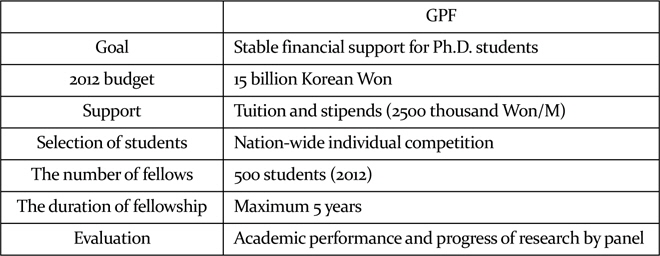
Summary of the GPF
BK 21 is one of the funding programs that support groups by supporting graduate students and post-doctoral scholars through selected research groups, especially in research-based universities (Seol, 2012). Another program that support groups, the WCU, aims at supporting research in new convergent fields and wants to transform research-oriented universities to a world-class level by recruiting distinguished foreign scholars.
In addition, graduate students can get financial benefits by participating in various research support programs such as the Advanced Research Center Programs (Science Research Center (SRC), Engineering Research Center (ERC), and National Core Research Center (NCRC)). GPF fellows are allowed to join in these programs and get additional support.
2. Determinants of Research Productivity
There are approximately 200 explanatory variables with respect to the scientists’ research productivity as reviewed by Babu and Singh (1998). Avital and Collopy (2001) reviewed the studies from 1974 to 1998 on the scientists’ research productivity. They denoted the main indices of research productivity as reputation, yield, influence and multidimensional studies. The reputation reflects the evaluation based on the rankings of academic institutions or the recognition of researchers, so it is not completely objective since it inevitably reflects subjectivity of the evaluators. The yield is indices that are related to publication such as the number of publications, the number of pages of publications, and the main or auxiliary authorship. The influence indicates the quality of research, such as the number of citations. And they suggest a combined index of reputation, yield and influence.
They also showed determinants of research productivity from various angles. The demographic research factors suggested are gender, age, race, ethnicity and marital status. The experience factors are career length, education quality, reputation of the Ph.D. program, and past and present research performance. In addition, other factors are based on individual motivation, such as high self-efficacy, participation in various research projects, clear research objectives, and individual characteristics such as leadership, ambition, activeness and independence. Besides, there are (i) institutional factors such as philosophy or mission of the institution, (ii) financial factors such as research funds and research cost, and (iii) cooperation factors such as constant contact with peers and joint research.
Previous studies showed halo effects and financial aid such as fellowships and professional training as the factors that influence the research productivity of graduate students. The halo effects mean the effects from the reputation of institutions or from supervisors (Crane, 1965). Graduate students are affected by the reputation of their institutions (Fox, 1983; Long, 1978; Hilmer and Hillmer, 2007; Park, 2007; Cho, 2007; Kim, 2008; Kim and Park, 2011), and that of their supervisors (Crane, 1965; Reskin, 1979; Long and Mcginness, 1985; Williamson, 2003; Pagils, Green and Bauer, 2006; Hilmer and Hillmer, 2007; Cho, 2007; Kim, 2008; Kim and Bak, 2011, Jang, 2013).
The halo effect can be used as motivation that influences college graduates to decide which graduate school they want to apply. Students, especially from low-ranked universities would like to apply to high-ranked universities. These trends influence research productivity of graduate students.
Financial aid for graduate students includes scholarships and research grants. Lariviere (2013) examined the correlation between research productivity and scholarship, and the correlation between degree completion and scholarship of Ph.D. students at Quebec University in Canada. And he found that the students who won scholarships published more papers than the students who did not win scholarships. Jang et al. (2012) also confirmed the discrepancy in research productivity depending on the different types of financial aid for graduate students in individual support programs or group support programs in Korea.
In addition, financial aid for graduate students influence not only research productivity but also degree completion. Degree completion can be included in research productivity because the research paper is the main determinant of degree completion. Jiranek (2010) presented that scholarships were an important factor for graduate students in chemistry and physics departments at the University of Adelaide in Australia to finish their theses on time. Wright and Cochrane (2000) also studied what influences Ph.D. completion at the University of Birmingham in England, and revealed that the students who were awarded research grants from the national science research councils had higher success rates in their thesis submissions.
In addition, professional training for graduate students through research projects affect research productivity as well. McCormick and Rice (2001) studied the correlation between research productivity and training at the graduate schools in the U.S. in the 1990s. They found the correlation between school rankings and research productivity is stable, and the high research productivity of low-ranked graduate schools comes from the variability of training. Therefore, professional training is one of the major factors that influence the graduate students’ research productivity (Hoskins and Goldberg, 2005).
III. Research Design and Analytical Methods
Data for this study is based on the annual reports from all of the 236 GPF fellows that were selected in 2011 who were all awarded financial support from the program for two years. The reports include their research and academic activities during the period. The information is composed of the number of articles published on Thomson Scientific SCI (Science Citation Index) Journals, the number of research projects financed by government or industries in which the fellows participated and the period that the fellows participated in research projects. The SCI articles of supervisors are obtained from the NRF’s Korean Research Index DB, which is the data of Korean researchers. The university ranking data is attained from the 2013 QS World University Ranking announced by Quacquarelli Symonds in September, 2013.
2. Definition and Measurements of the Variables
2.1 Variable of Research Productivity
Many studies (Fox, 1983; Jang et al., 2012; Kim, 2008; Crane, 1965; Reskin, 1979; Cardoso et al., 2008; Lariviere, 2013) use the number of publications as the indices for research productivity of scientists and that of graduate students as well. This study also defines articles published in the SCI journals as research productivity.
2.2 Explanatory Variables
This study scrutinized previous studies and selected the demographic research factors and the financial aid factors through research support programs and the affiliated institution’s reputation factor and the supervisor factor as the determinants of research productivity of graduate students. In particular, this paper classified the halo effect as the affiliated institution halo effect and the supervisor halo effect. Thus, the definition and hypothesis of the selected variables are the following.
First, the demographic factors are categorized into gender and age. Jang et al. (2012), one of the previous studies on the gender effects on research productivity, presented that male graduate students are significantly more excellent than female graduate students in academic performance, as measured by the number of journal publications and the number of papers they plan to submit to journals. On the contrary, Park (2007) claimed that there is no gender difference in research productivity of the scientists for the first few years of their graduate school enrollment.
Second, several studies analyzed the difference in research productivity depending on age groups (Park, 2007; Kim and Bak, 2011), and Park (2007), in particular, argued that research productivity of the younger groups is higher. In line with these studies, this study grouped the students into two groups: the 20s and over 30. Usually, students who started a joint MA-Ph.D. program can participate in the programs of NRF from the age of 24, and male students who start Ph.D. programs after finishing military service and Master’s program are usually 29. Six of the students were in their 40s, but they were too few to be separately grouped, so the students were grouped into 20s and over 30.
This study sets the following hypotheses:
Hypothesis 1-1: There is no gender difference in the graduate students’ research productivity. Hypothesis 1-2: The younger group of graduate students shows higher research productivity.
The second explanatory factor that affects graduate students’ research productivity is the financial factor. Previous studies classified the financial factor into scholarships and research grants, and reported that the funded graduate students publish more papers than their peers (Lariviere, 2013; Jiranek, 2010). Jang et al. (2012) also claimed that there is a difference in research productivity depending on the types of scholarships or research grants. Therefore, this study classified the financial factors into three groups: students only supported by the GPF program, students funded by both GPF and the BK21 program, and students who are supported by the GPF and other programs at the same time.
Hypothesis 2: Graduate students’ research productivity differs depending on the type of financial support.
The third explanatory factor that affects the graduate students’ research productivity is the reputation of institutions. Much previous research (Fox, 1983; Long, 1978; Hilmer and Hillmer, 2007; Park, 2007; Cho, 2007; Kim, 2008; Kim and Bak, 2011) shows a positive correlation with the graduate students’ research productivity. Thus, this study applied the 2013 QS World University Ranking to the indices for the reputation of graduate schools, and made the following hypothesis.
Hypothesis 3: The reputation of graduate schools has a positive effect on the graduate students’ research productivity.
The last explanatory factor is the supervisor factor. The supervisor factor is classified into the research productivity of supervisors and professional training. Supervisors’ research productivity is calculated by the number of their publications, and it has a positive correlation with the graduate students’ research productivity (Crane, 1965; Reskin, 1979; Long and Mcginness, 1985; Pagils, Green and Bauer, 2006; Hilmer and Hillmer, 2007; Cho, 2007; Kim, 2008; Kim and Bak, 2011, Jang, 2013). Crane (1965) defined this positive correlation as the halo effect. This study measured the supervisors’ research productivity with the number of their publications in the SCI journals from 2010 to 2012.
In addition, getting special training from supervisors such as data collection, analysis, research methodologies and management by participating in research projects funded by government and private enterprises has a positive influence on the graduate students’ research productivity (McCormick and Rice, 2001). This study defines professional training as the supervisors’ halo effect and measured it with the number of research projects in which graduate students participated in for two years from 2011 to 2012.
Hypothesis 4-1: Supervisors’ research productivity (the number of publications) has a positive influence on graduate students’ research productivity. Hypothesis 4-2: Professional training by supervisors through research projects has a positive influence on the graduate students’ research productivity.
2.3 Research Methods and Data
This study measures graduate students’ research productivity using their number of publications in SCI journals. Then, the factors that influence research productivity are classified into demographic factors (gender and age), types of support programs, reputation of institutions, and the halo effects of supervisors (the supervisors’ research productivity and research projects). To achieve the purpose of this paper, the correlations between research productivity and the supervisor factors are analyzed, and the influences of other factors on research productivity are examined, using the SAS software. The statistical significance is tested with F-tests and T-tests.
Among all 236 students, 117 students published in SCI journals and total publications numbered 423. Among them, 50 (21.1%) students are in humanities and social sciences and two of them published two papers in SCI journals. Total number of SCI papers is more than the papers they published in non-SCI journals (32 papers) and domestic journals (100 papers).
As shown in Table 2, among 14 academic disciplines, 50 graduate students were in Humanities and Social sciences (21.1%), 28 in Life science (11.9%) and 24 in Chemistry (10.2%). The ratio of authors in each discipline is Materials 100.0%, Chemistry 79.2%, Information & Communication 78.6% and Mechanical Engineering and Multidisciplinary (S&T) 76.5% respectively. In addition, the number of SCI publications per student who published in the SCI journals by disciplines is Chemistry and Electronics & Electricity, 5.3 papers respectively, and Materials 5.1 papers. By discipline, the ranks are Chemistry (100 papers), Life Science (54 papers), Electronics & Electricity (42 papers) and Materials (41 papers). The number of SCI journal publications per the students who participated in the research support programs is Materials 5.13 papers, Chemistry 4.17 papers and Electronics & Electricity 2.8 papers.
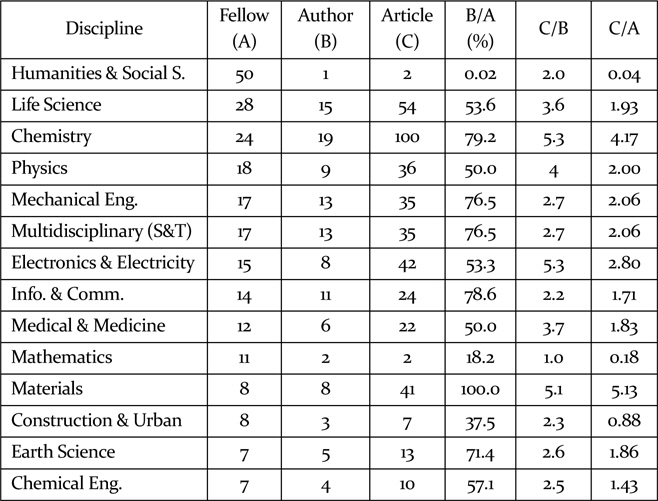
SCI and discipline
The institutions of the graduate students are 19 universities. In these universities, 49% of the students, about 1 in 2, published in SCI journals. 7 universities had more than ten students, and among them a 53.3% author ratio was the highest.
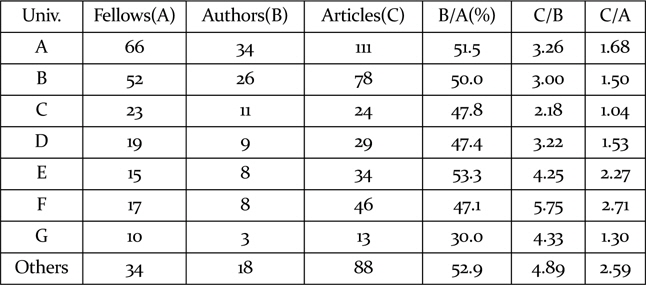
Big universities
1. Demographic Factor and Research Productivity
This study analyzed the demographic factor that influences research productivity by classifying it into gender and age. 146 students were male, and 90 of them were female. According to the analysis of gender and the number of publications, no gender difference was found (t=2.536, p=0.012).
154 students in their 20s and 82 of them were over 30. The number of publication per student is 1.89 for 20s and 1.59 for over 30. The number of articles shows a significant difference between the two age groups (t=0.688, p=0.492). Therefore, it is confirmed that the younger group has higher research productivity.
[Table 4] Productivity of research by gender and age

Productivity of research by gender and age
2. The Types of Financial Support and Research Productivity
61.86% (n=62) of students are only funded by GPF, and they published an average of 3.45 papers, and this represents lower research productivity than other participants but the difference was not significant (F = 0.5, p = 0.6086). This signifies that there is no conclusive proof that additional funding increases research productivity.
[Table 5] SCI and funding program participation of fellows

SCI and funding program participation of fellows
3. Institutions and Research Productivity
3.1 Reputation of Institutions
To analyze the difference in research productivity of graduate students by the reputation of their institutions, this study grouped the universities into two groups: one group in the top 200 and the second group under the top 200 in the 2013 QS World University Ranking. Table 6 shows a much higher proportion of students in highly ranked universities.
[Table 6] GPF fellows by university rank group

GPF fellows by university rank group
Concerning the average number of SCI publications by university reputation, the graduate students under 200 (n=17) published 4.88 papers, and the students in the top 200 (n=100) published 3.4 papers, and it was significant at the 15% significance level, but not at the 5% level (t = 1.53, p = 0.12). It means that lower ranked university students might publish more than students in high ranked universities. Thus, there is no significant halo effect from the reputation of institutions.
[Table 7] SCI and university rank

SCI and university rank
3.2 Pursuit of Reputation
To scrutinize the halo effect in institutions, this study checked the mobility effect of students between bachelor universities and graduate universities. First, the students in the same university in undergraduate and graduate programs (n=71) showed higher research productivity (3.7 publications) than the students (n=46) who switched schools (3.6 publications). But the difference was not significant (t=0.188, p=0.851).
[Table 8] Mobility and SCI publications

Mobility and SCI publications
Second, this study checked the students’ mobility effect between bachelor universities and graduate universities. Mobility was classified into 4 types as shown in Table 9. The average research productivity was the highest when the students (n=14) went to the graduate school of the same university which is ranked under 200, and it was the lowest when students (n=20) switched schools from the university ranked under 200 to one ranked in the top 200. But there was no significant difference among groups (F = 2.15, p = 0.983).
[Table 9] Types of university mobility and SCI publications

Types of university mobility and SCI publications
Third, since the reputation of institutions does not have significant influence on the graduate students’ research productivity, this study analyzed the correlation between the reputation of institution and the research productivity of supervisors. The supervisors’ research productivity at the universities ranked in the top 200 (n=184, 16.3 publications) was lower than the research productivity of advisors’ at the universities ranked under 200 (n=34, 18.5 publications), but it was not significantly different (t = 0.69, p = 0.492).
[Table 10] University rank and SCI of supervisors

University rank and SCI of supervisors
4. Supervisor and Research Productivity
4.1 Research Productivity of Supervisor
218 supervisors advised 236 students. To examine the influence of the research productivity of the supervisors on that of graduate students, this study analyzed the correlation between the two. According to the analysis, research productivity of supervisors and graduate students has a positive correlation of 0.30699 (p=0.0012). This signifies that there is the halo effect from advisors.
[Table 11] Correlation of research productivity

Correlation of research productivity
This study also examined if the number of students who participated in the program influences the research productivity of supervisors. Among 218 advisors, 202 of them had only one advisee and 14 of them had two, and two of them had three students. The research productivity of supervisors who have more students in the program was significantly higher (F = 3.23, p = 0.041).
Since graduate students conduct research under the supervision of their supervisors and publish together, if the supervisors have more graduate students with high research productivity, they may publish more research papers.
[Table 12] SCI and fellow number of supervisors

SCI and fellow number of supervisors
4.2 Professional Training (Participation in Research Projects)
Among 236 students, 147 of them (62.3 %) participate in research programs which are called professional training factors. To examine how professional training from supervisors influence graduate students’ research productivity, this study analyzed the number of research projects, the duration of their participation in the projects and the types of the research projects. According to the analysis, there was no significant correlation between research productivity and the number of research projects and the duration of their participation in the research projects respectively.
[Table 13] Correlation between projects and research productivity

Correlation between projects and research productivity
Research productivity increased as the number of research projects that graduate students participated reached three, but decreased after four. This signifies that participation in research projects have positive influence on research productivity, but excessive participation in research projects have negative influence on research productivity.
[Table 14] Number of projects and SCI
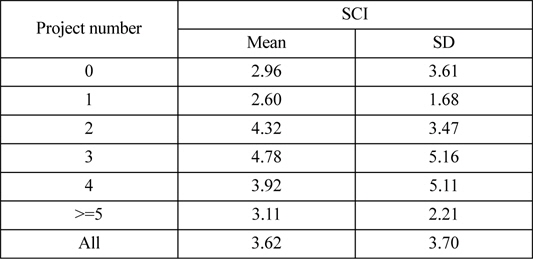
Number of projects and SCI
On the other hand, research projects are classified into projects from government and industry. 77.5% of graduate students who conducted research projects participated in the government projects, and 6.8% of them participated in industry projects and 15.6% of them participated in both. Research productivity based on the type of research projects differed in the mean of SCI publications, but it was not significant (F = 1.68, p = 0.1918). Thus, the type of research project is not an influence in the number of SCI publications.
[Table 15] Types of research project participation
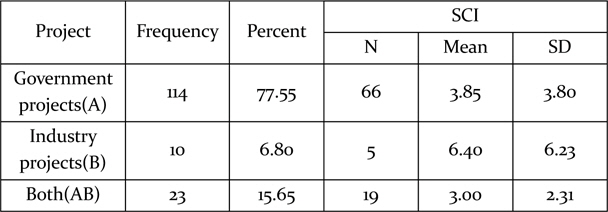
Types of research project participation
4.3 Correlation between Supervisors and Fellows
The correlation between research productivity of supervisors and students in the universities ranked in top 200 is significant (p <.01), but no significant correlation was found for the universities ranked under 200.
[Table 16] Correlation between SCI of supervisors and fellows

Correlation between SCI of supervisors and fellows
By discipline, 56.41% of the SCI authors are engineering, 42.74% science, and 0.85% humanities and social sciences. As for the research productivity of supervisors and students, only sciences had a positive correlation (p <.001).
[Table 17] SCI authors by majors

SCI authors by majors
The aim of this study is to analyze what are the factors that influence the research productivity of the graduate students who participated in GPF programs of NRF. The research productivity was measured by the number of SCI publications, and the explanatory factors are the demographic factor, the financial factor, the reputation of institutions and the supervisor factor. Based on this, the following hypotheses were made:
Hypothesis 1-1: There is no gender difference in the graduate students’ research productivity. Hypothesis 1-2: The younger group of graduate students shows higher research productivity. Hypothesis 2: The graduate students’ research productivity differs depending on the types of the financial support. Hypothesis 3: The reputation of affiliated graduate schools have a positive (+) effect on the graduate students’ research productivity. Hypothesis 4-1: The supervisors’ research productivity (the number of publications) has a positive influence on the graduate students’ research productivity. Hypothesis 4-2: The professional training from the supervisors through research projects has a positive influence on the graduate students’ research productivity.
The results of the analysis are summarized as below:
The average number of SCI publications was higher for male graduate students (2.19) than for female students (1.13), but it was not significant (p=0.012), so the hypothesis 1-1 is confirmed. This suggests that both females and males in the early stage of graduate study may be free from nursing and family obligations, thus having more time to study. According to the analysis of the research productivity by age, the graduate students in their 20s published more papers in SCI journals (1.89) than the students over 30 (1.59), and it was significant (p=0.492), thus, the hypothesis 1-2 is accepted. It may tell us that younger students are more motivated and enthusiastic about research or graduate studies. Hypothesis 2 is rejected, because there is no difference in the research productivity even if the graduate students are supported by the GPF and other programs at the same time. In the mean of SCI publication, graduate students at the universities ranked under 200 were more productive (4.9 SCI publications) than the students at the universities ranked in top 200 (3.4 SCI publications). But it was not statistically significant (t=1.53, p=0.12). So, hypothesis 3 is rejected. The research productivity of supervisors and graduate students has a positive correlation, so hypothesis 4-1 is confirmed. Concerning the professional training via the number of research projects and the duration of the projects given by supervisors, no correlation with the graduate students’ research productivity was found. Thus, hypothesis 4-2 is rejected.
2. Contribution and Limitations
The contribution of this paper is twofold, one a theoretical point of view, and the other a practical point of view. First, the theoretical contribution is the following: This study defined the halo effect as the reputation of institutions and the research productivity of the supervisors and professional training through research projects, but only the research productivity of supervisors had a significant influence on graduate students’ research productivity. Thus, the research productivity of the supervisor is an important factor because it has a direct influence on the research productivity of graduate students unlike other halo effect factors. This highlights the important role of supervisor as a professional expert and facilitator for research activities of graduate students.
Next, the contribution of this study from the practical point of view is presented below: It is important to maintain an optimum number of projects in which students are involved. Research productivity increased until three projects, but decreased from 4 projects. Participation in too many research projects may result in lower research productivity, due to decreases in concentration. However, more study is needed to find the optimum number of projects for graduate students. Second, NRF should consider the research productivity of supervisors when they select graduate students. In addition, participation of the universities ranked under 200 in the programs should be recommended since the research productivity of students from the universities ranked under 200 might be relatively higher. Graduate students funded by the GPF program were selected through fierce competition procedures requiring a high GPA and English test score. So even though the number of students from universities ranked under 200 is small, they are very competitive. Therefore the results suggest that research productivity of GPF beneficiaries may not be influenced by university ranking, but by individual competencies.
Meanwhile, the limitations of this study are given below: The data for this study is obtained from the annual reports of research productivity of the graduate students who were funded by the GPF program of NRF. Thus, this study has limited points of views. In addition, this study used the number of SCI publications as an index for research productivity. Dissertations, patents and published books could also be included in research productivity. Lastly, this study does not reflect the productivity difference between disciplines.
















